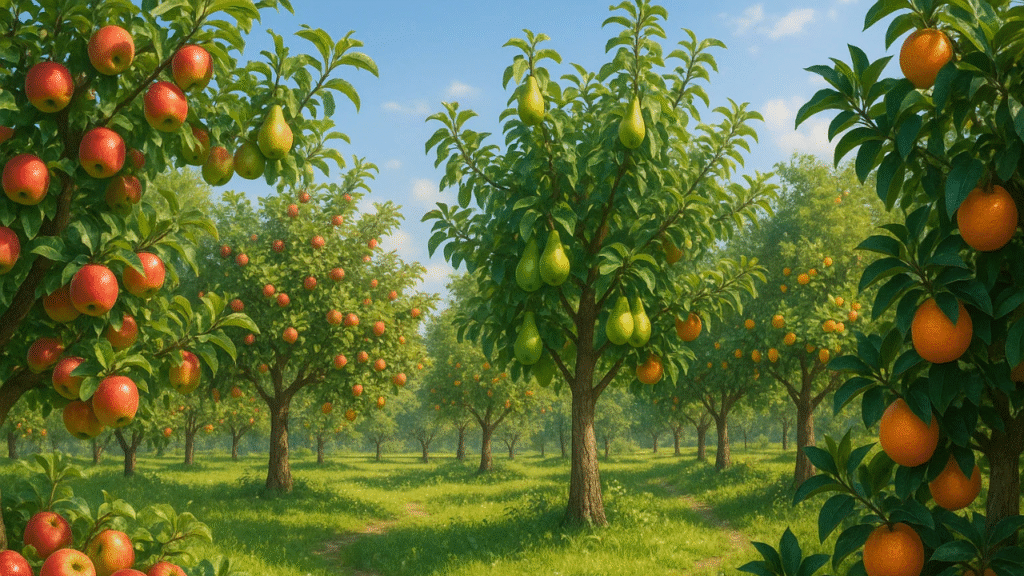
How Grafting Fruit Trees to Increase Yield Can Boost Your Harvest: A Complete Guide
Imagine harvesting a bountiful crop of fruit from a tree that once struggled to produce even a handful. What if there was a simple technique that could transform your tree into a high-yield powerhouse? Grafting fruit trees to increase yield is exactly that – a powerful method used by gardeners and orchardists worldwide to boost production and ensure healthier, more productive trees. Whether you’re a seasoned gardener or just starting, this guide will walk you through the benefits, techniques, and step-by-step process of grafting, helping you unlock the full potential of your fruit trees and achieve the harvest you’ve always dreamed of. 🍎
Table of Contents
Toggle🌳 What is Grafting and How Does It Work? 🌳
Grafting is a horticultural technique where parts of two different plants are joined together to grow as one. 🌱 This method allows gardeners to combine the best qualities of two trees—such as a strong rootstock and a fruit-producing scion—to create a healthier, more productive plant.
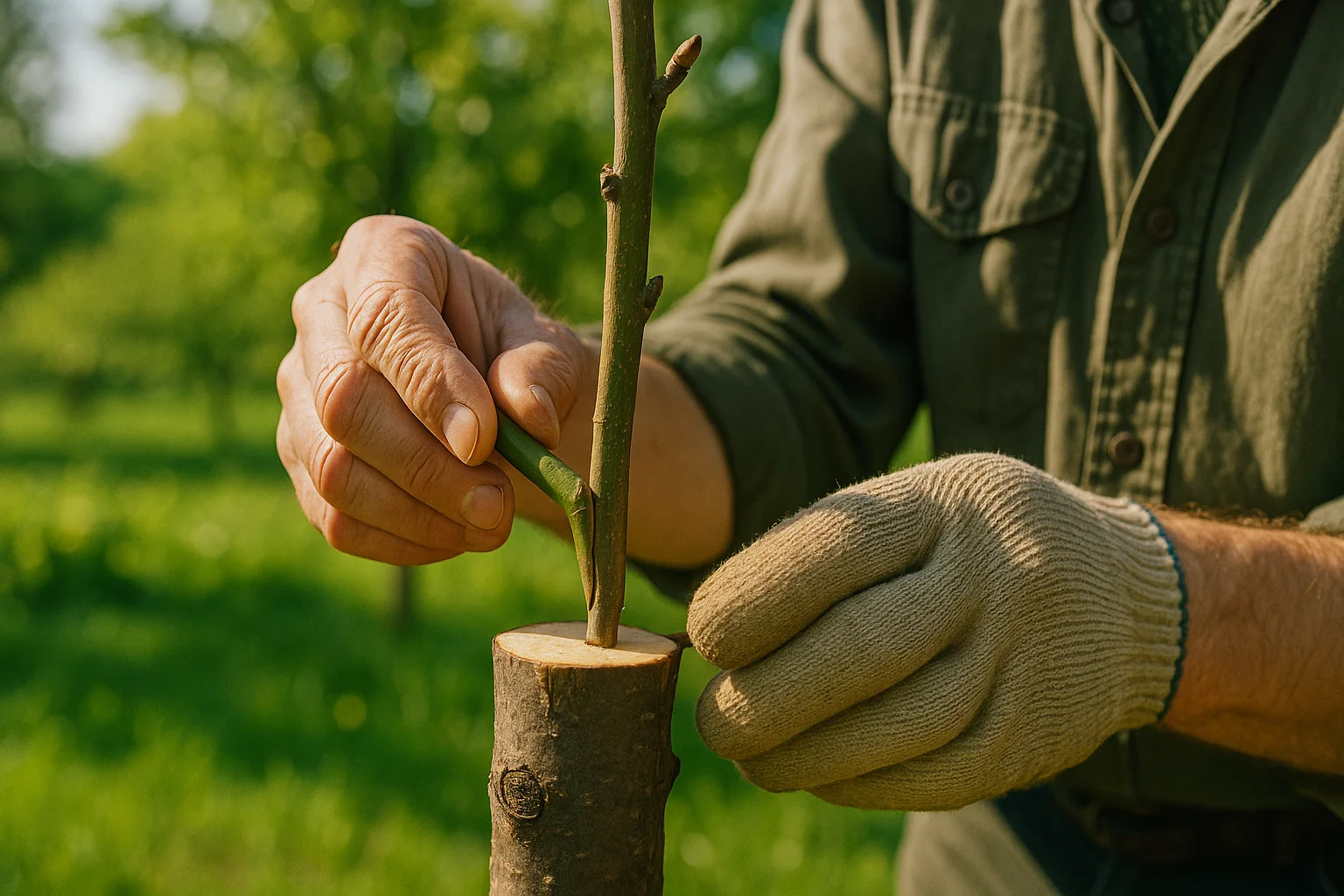
In grafting, the rootstock (the bottom part) provides the roots, while the scion (the top part) contributes the desired fruiting variety. 🍎 When the two parts are carefully joined, they form a single tree that benefits from both the strength of the rootstock and the superior fruiting ability of the scion.
The process works because, over time, the tissues of the rootstock and scion connect and grow together. 🌿 The grafting site acts like a bridge, allowing nutrients and water to flow efficiently between the two parts, ensuring optimal growth.
Why does grafting increase yield? By using a rootstock that’s well-suited to the soil and climate, you can improve the tree’s overall health and fruit-bearing ability. 🍇 This means your tree can produce more fruit, often faster and with greater resistance to diseases.
In short, grafting helps you grow stronger, more productive fruit trees—making it an essential technique for anyone looking to boost their harvest! 🍊
🍏 Benefits of Grafting Fruit Trees 🍏
Grafting fruit trees offers numerous benefits, making it an excellent choice for gardeners looking to boost their yields and improve tree health. Here’s why grafting is so effective:
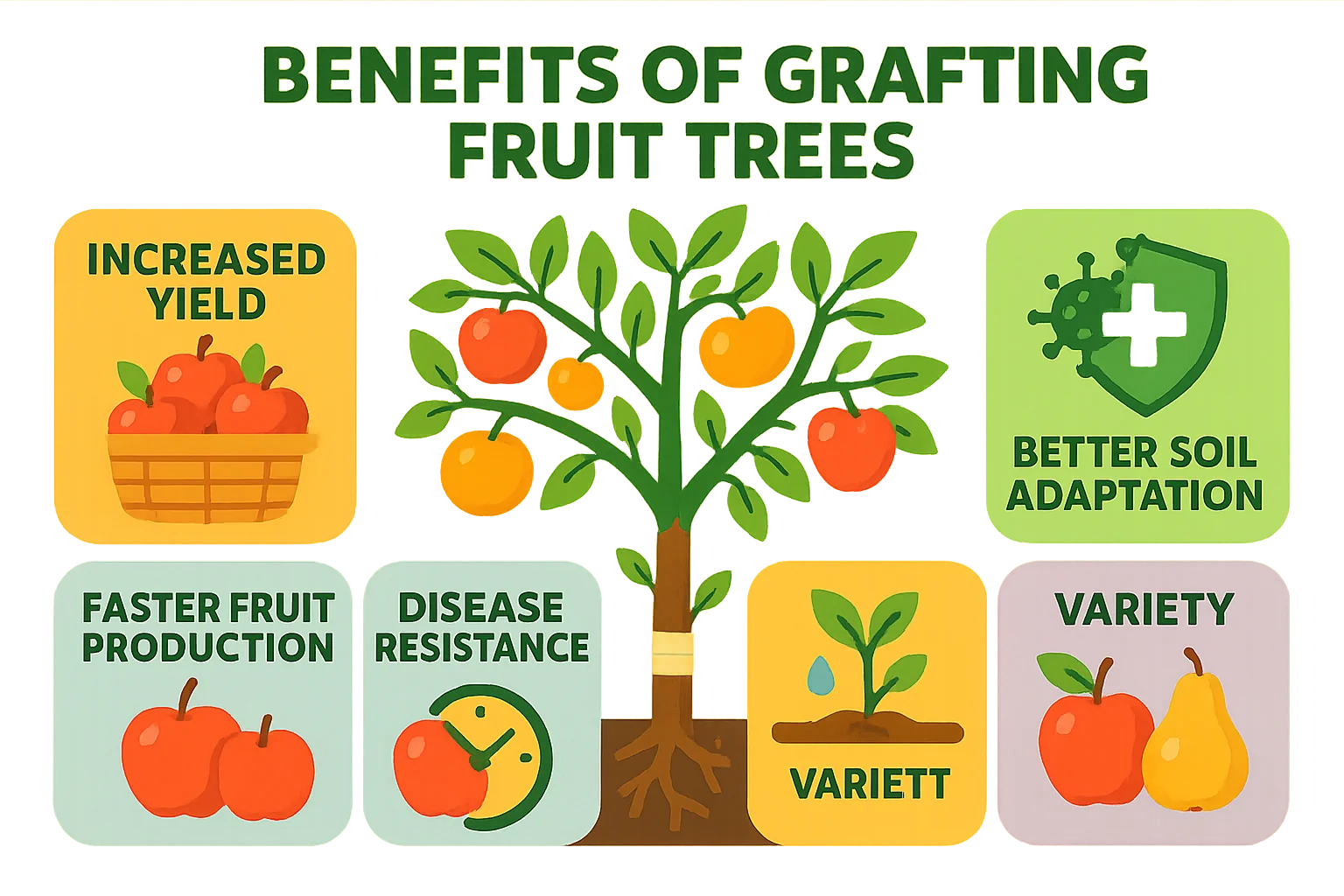
1️⃣ Increased Yield 🍏
Grafting can significantly increase the amount of fruit your tree produces. By selecting the right rootstock and scion, you can encourage quicker fruiting and a larger harvest—sometimes even from older trees! 🌳
2️⃣ Faster Fruit Production 🍒
Certain rootstocks can speed up the time it takes for a tree to bear fruit. This is especially helpful for gardeners eager to enjoy their fruits sooner. ⏱️
3️⃣ Improved Disease Resistance 🦠
Using a strong, disease-resistant rootstock helps protect the entire tree from common soil-borne diseases, ensuring healthier growth and better yields. 🌿
4️⃣ Better Adaptation to Soil and Climate 🌍
Grafting allows you to select a rootstock that thrives in your soil type and climate, making your tree more resilient and productive. 🌱
5️⃣ Variety and Diversity 🍑
Grafting gives you the flexibility to combine different fruit varieties on a single tree. Imagine growing apples, pears, and cherries all on one tree—perfect for small gardens! 🌳
In summary, grafting not only boosts your tree’s productivity but also enhances its overall health and adaptability. It’s a simple yet effective way to grow stronger, more fruitful trees! 🌿
🍏 Best Fruit Trees for Grafting 🍏
Not all fruit trees are equally suited for grafting. Some varieties work better with grafting techniques, ensuring a more successful outcome and better yields. Here are the best fruit trees to graft:

1️⃣ Apple Trees 🍏
Apple trees are among the most common and easiest to graft. You can graft multiple apple varieties onto a single tree, offering a variety of flavors in one space. 🌳
2️⃣ Pear Trees 🍐
Pear trees also graft well, especially when grafting different pear varieties. A successful graft can help increase the quantity and quality of pears. 🍐
3️⃣ Peach and Nectarine Trees 🍑
Peaches and nectarines respond wonderfully to grafting, allowing you to combine different varieties on one tree, which can extend the harvest period. 🍑
4️⃣ Citrus Trees 🍊
Citrus trees, such as oranges, lemons, and limes, are excellent candidates for grafting. Grafting citrus allows for faster fruit production and can improve disease resistance. 🍊
5️⃣ Plum Trees 🍑
Plum trees graft easily, and you can even combine European and Japanese plum varieties on one tree for a more diverse harvest. 🍑
6️⃣ Cherries 🍒
Cherries are another great option for grafting, especially when you want to graft multiple sweet and sour varieties for a longer harvest period. 🍒
🌱 Choosing the Right Rootstock 🌱
When selecting the right rootstock, it’s important to choose one that suits your soil, climate, and tree size. The right rootstock will determine how quickly the tree matures, how much fruit it produces, and how resistant it is to diseases.
With these fruit trees, grafting can lead to higher yields, faster fruiting, and a stronger, healthier tree. Happy grafting! 🌳 Grafting Fruit Trees to Increase Yield is a proven strategy to make the most of your orchard space and effort.
🛠️ Step-by-Step Guide to Grafting Fruit Trees 🛠️
Grafting fruit trees is easier than you might think! Follow this simple step-by-step guide to graft your trees successfully and boost your harvest. 🌱
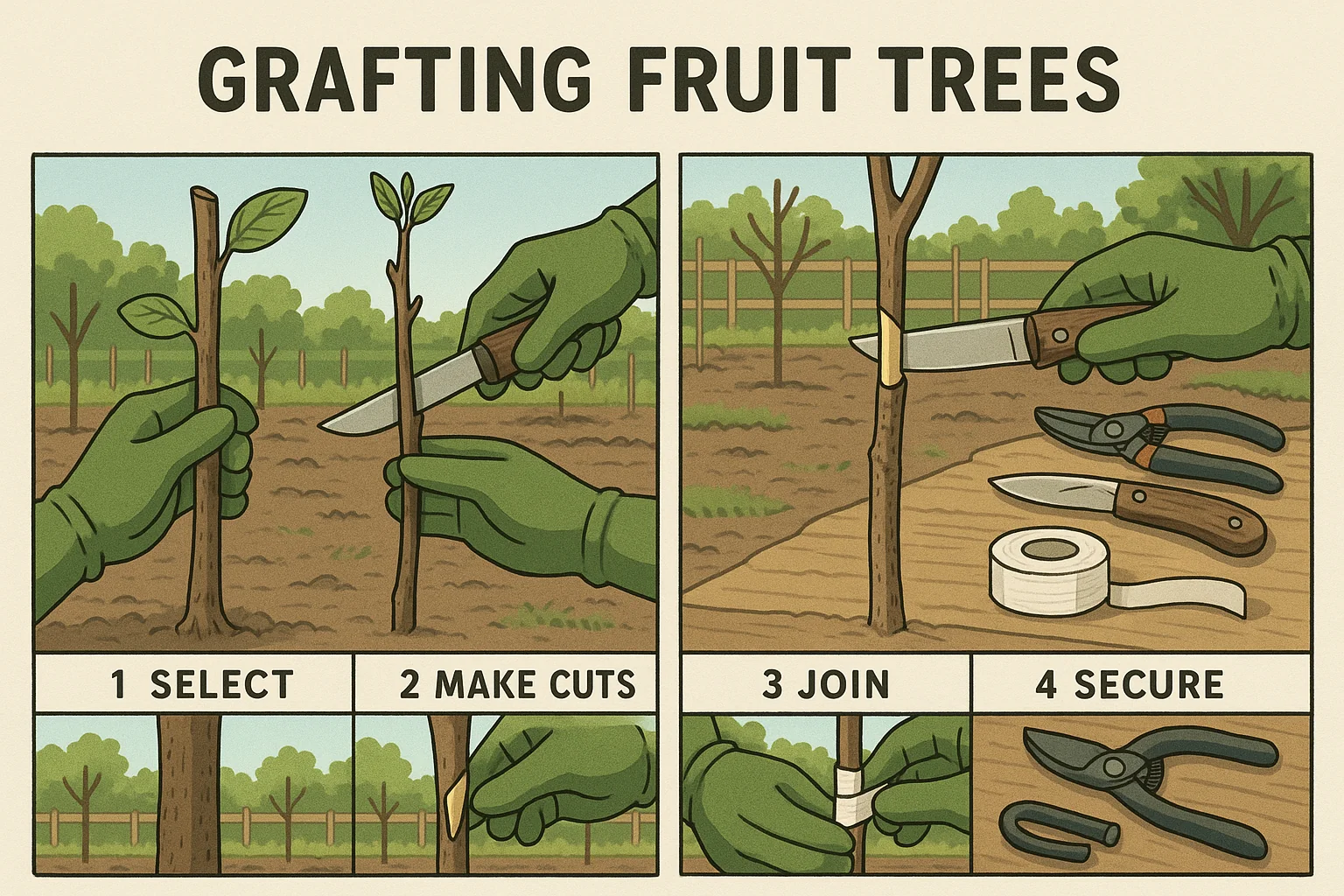
Materials You’ll Need:
- Grafting knife or sharp knife 🗡️
- Grafting tape or parafilm 🎋
- Pruning shears ✂️
- Grafting wax (optional) 🕯️
- A healthy rootstock and scion (the part you want to graft) 🌿
🌱 Step 1: Select Your Rootstock and Scion
- Rootstock: Choose a healthy, disease-free rootstock that suits your soil and climate. 🌱
- Scion: Select a scion from a fruit tree you want to propagate. The scion should be a healthy, disease-free branch with the same diameter as the rootstock. 🌿
✂️ Step 2: Prepare the Rootstock
- Use pruning shears to cut the rootstock to the desired height, typically around 6-8 inches above the soil level. ✂️
- Make a clean, straight cut across the rootstock to expose the cambium layer (the soft tissue just beneath the bark). 🌱
🌿 Step 3: Prepare the Scion
- Cut a piece of scion about 6-8 inches long. Make sure the cut end is a clean, sharp diagonal that matches the angle of the rootstock cut. 🍃
- The scion should have at least 2-3 buds on it. 🌿
🌳 Step 4: Join the Rootstock and Scion
- Align the cambium layers (the green tissue just beneath the bark) of both the rootstock and scion. Proper alignment is crucial for a successful graft! 🌱
- For cleft grafting, make a vertical split in the rootstock and insert the scion into the split. For whip-and-tongue grafting, make matching cuts on both the rootstock and scion, then fit them together like puzzle pieces. 🧩
🎋 Step 5: Secure the Graft
- Use grafting tape or parafilm to wrap the graft site tightly, ensuring that the scion and rootstock are held together securely. 🎋
- Optionally, apply grafting wax to the exposed cut surfaces to prevent moisture loss and infection. 🕯️
🚿 Step 6: Aftercare
- Keep the grafted tree in a shaded, warm spot while it heals. 🌞
- Water the tree carefully but don’t overdo it. You want the graft to heal without being too soggy. 💧
- Monitor the graft over the next few weeks. If it starts to sprout, the graft has been successful! 🌿
✂️ Step 7: Remove the Grafting Tape
- Once you see the scion growing well, remove the grafting tape. This will allow the tree to grow naturally. Make sure to prune any unwanted shoots that appear on the rootstock. ✂️
By following these easy steps, you can successfully graft fruit trees to increase your yield and enjoy a bountiful harvest. 🌳 Grafting Fruit Trees to Increase Yield is a smart technique that empowers even beginner gardeners to enhance productivity.
🌱 Troubleshooting Common Grafting Problems 🌱
Grafting fruit trees is a rewarding process, but sometimes things don’t go as planned. Don’t worry! Here are some common grafting problems and how to solve them. 🌿
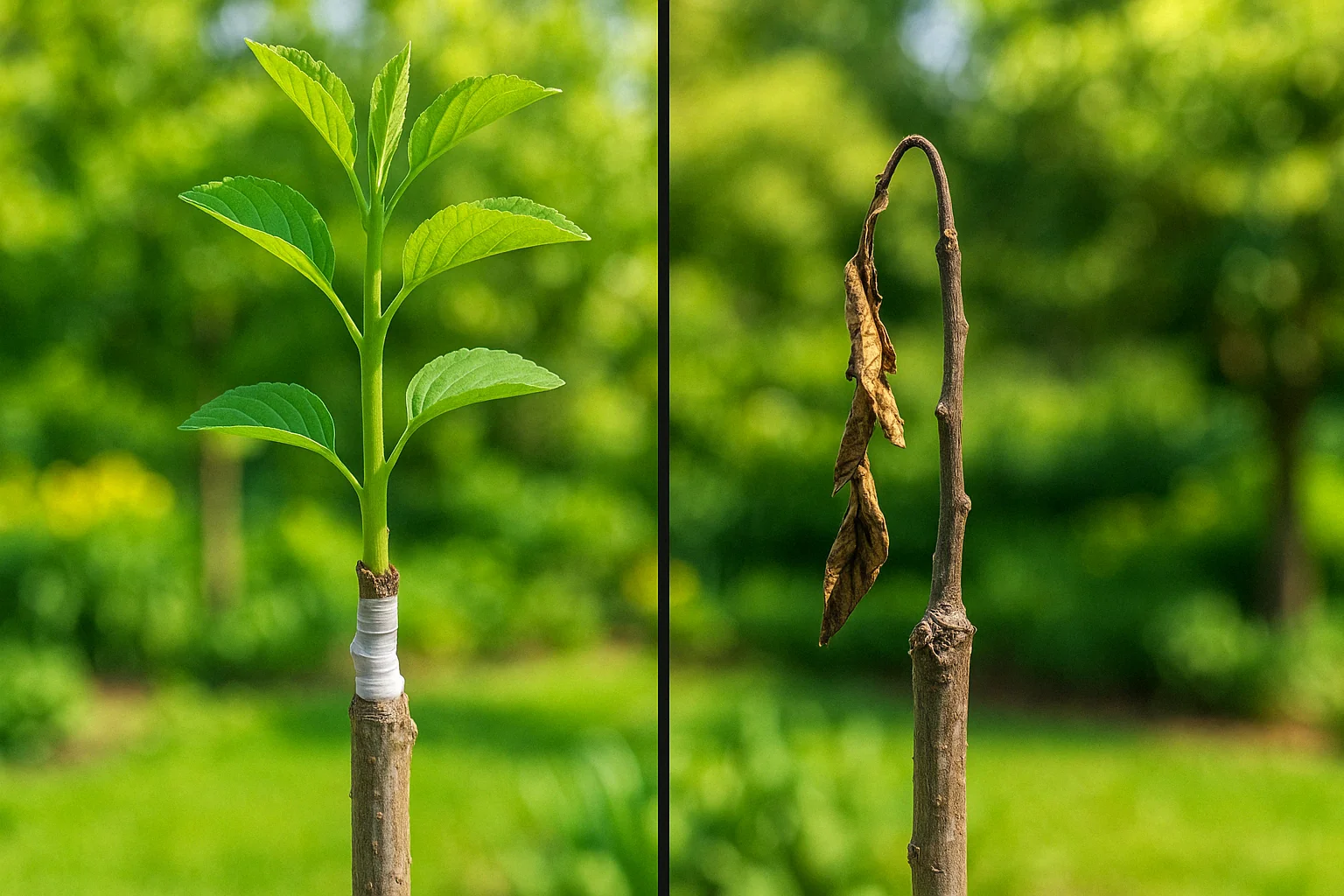
1️⃣ Graft Failure (No Growth) 1️⃣
Problem: After grafting, the scion doesn’t sprout, and the graft site looks dry or shriveled.
Solution: This can happen if the cambium layers of the scion and rootstock didn’t align properly. Ensure the cuts are clean and well-matched next time. If failure happens, try re-grafting or using a different scion. 🌱
2️⃣ Graft Becoming Loose 2️⃣
Problem: The graft tape or parafilm loosens, and the scion isn’t secure.
Solution: Tighten the grafting tape and make sure it’s wrapped firmly. Use grafting wax around the edges if needed to secure it further. Make sure there’s no air gap between the rootstock and scion. 🎋
3️⃣ Poor Scion Growth 3️⃣
Problem: The scion starts to grow weakly or not at all.
Solution: This could be due to insufficient sunlight, too much water, or the scion being too old or damaged. Place your grafted tree in a warm, well-lit location and ensure it’s not overwatered. 🌞💧
4️⃣ Graft Takes Too Long to Heal 4️⃣
Problem: The graft site takes too long to heal, and the scion isn’t growing.
Solution: This may happen if the tree isn’t getting enough warmth. Make sure the graft is kept in a warm environment with consistent humidity. Sometimes, adding a plastic bag over the graft can help retain moisture. 🌡️
5️⃣ Infection or Rot 5️⃣
Problem: The graft site turns brown, mushy, or shows signs of rot.
Solution: This often indicates infection, usually from excessive moisture or an improper graft. Ensure the graft site is properly sealed and apply grafting wax to prevent moisture from entering. If rot is evident, remove the infected scion and try again with a new, healthy one. 🦠
6️⃣ Shoots on Rootstock 6️⃣
Problem: The rootstock starts sprouting shoots instead of the scion.
Solution: Remove these unwanted shoots as soon as they appear. They can divert energy away from the graft. Make sure to monitor and prune regularly to maintain the strength of the grafted section. ✂️
By addressing these common issues, you can ensure a higher success rate with your grafting projects and enjoy healthier, more productive fruit trees! 🌳🍏
🍏 Real-Life Success Stories (Optional) 🍏
Sometimes, seeing how grafting can transform a garden is the best motivation! Here are a couple of real-life success stories that show how grafting fruit trees can increase yield and improve overall tree health. 🌿
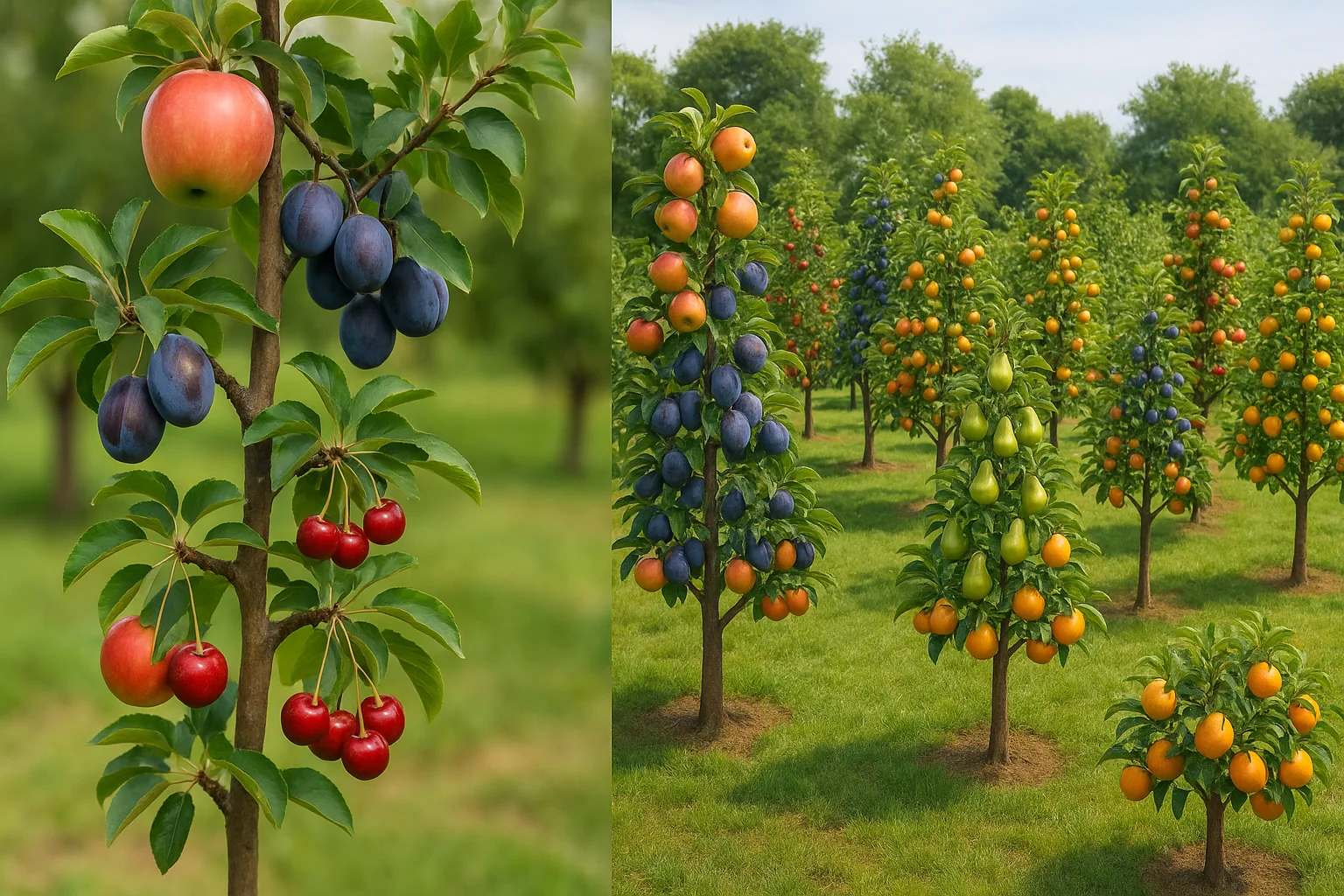
1️⃣ Sarah’s Backyard Orchard 1️⃣
Sarah had a small backyard orchard with several fruit trees, but her apple trees just weren’t producing as much as she had hoped. After researching grafting, she decided to graft a few of her trees with high-yield apple varieties. 🍏
Within a year, her grafted apple trees produced an abundance of juicy, sweet apples! By combining different apple varieties on the same tree, Sarah was able to extend her harvest season, making her orchard even more fruitful. She now enjoys a variety of apples all season long and is amazed at the improvement in yield.
2️⃣ Mark’s Multi-Fruit Tree 2️⃣
Mark, a passionate gardener, wanted to maximize space on his small plot of land. He decided to graft multiple fruit varieties onto one tree. He used a healthy pear rootstock and grafted apples, plums, and cherries onto it. 🍐🍒🍏
The result? Mark’s single tree became a “fruit salad tree,” producing multiple types of fruit on one tree! The diversity of the fruit harvest was incredible, and the tree thrived, thanks to the strong rootstock. Mark was able to increase his yield without taking up extra space in his garden.
3️⃣ Emily’s Organic Orchard 3️⃣
Emily runs an organic orchard and had been struggling with disease in her peach trees. After grafting her peach trees onto disease-resistant rootstocks, she noticed a huge difference. 🌱
The grafted trees not only produced more fruit, but they were also healthier and more resistant to pests. Emily was thrilled with the results, as her harvests were more abundant and the overall health of her orchard improved.
These success stories prove that grafting can be a game-changer for fruit trees. Whether you want to boost your yield, improve tree health, or maximize space, grafting is a fantastic solution! 🌳🍇 Grafting Fruit Trees to Increase Yield has become a popular method among gardeners and orchardists for its proven benefits.
🌱 Maintenance Tips to Ensure Long-Term Success 🌱
Once you’ve successfully grafted your fruit trees, it’s important to maintain them properly to ensure they thrive for years to come. Here are some essential maintenance tips to help you enjoy a bountiful harvest year after year. 🌱
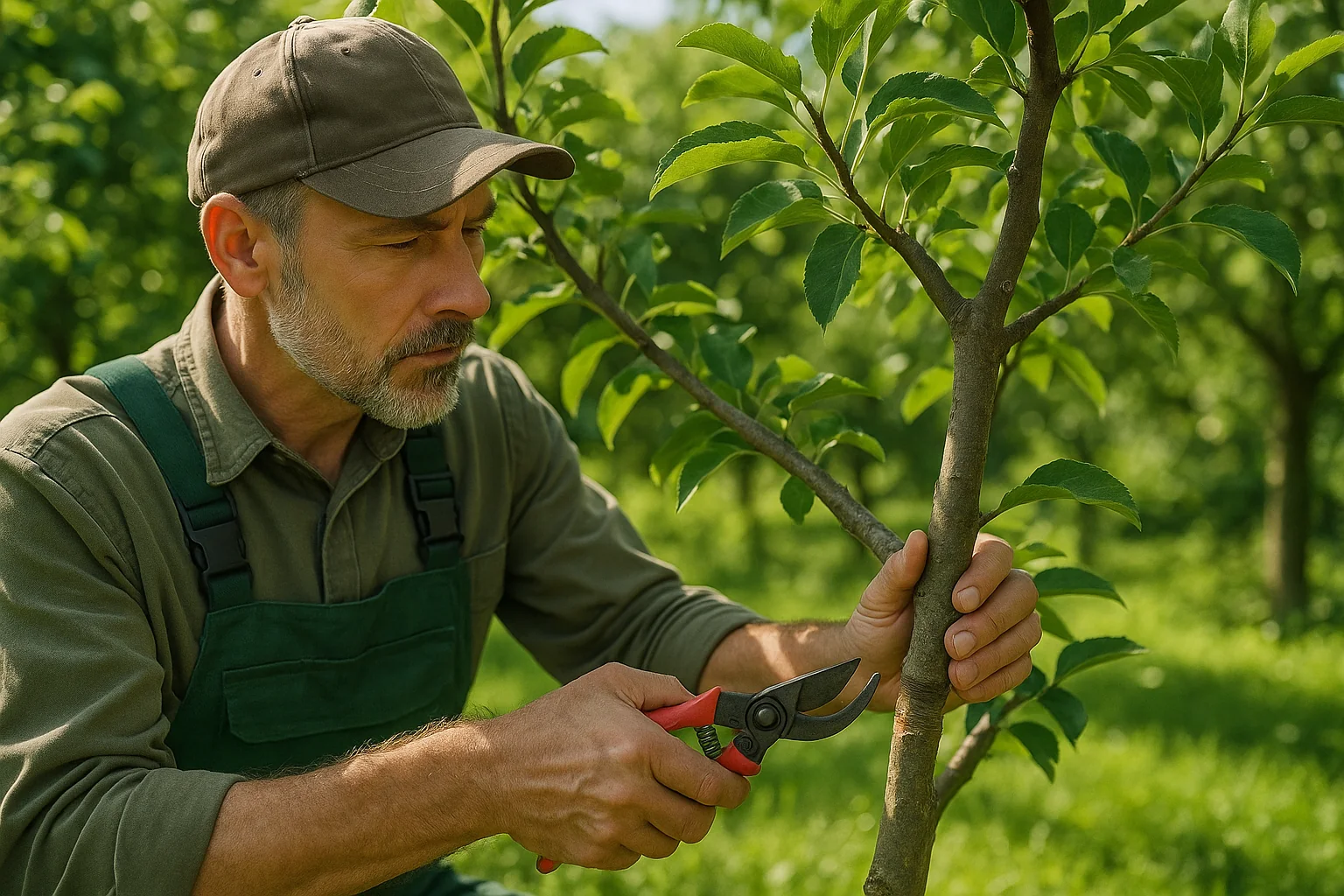
1️⃣ Regularly Check the Graft Site 1️⃣
- Why it’s important: Keep an eye on the graft site to make sure it stays healthy and secure. Look for signs of graft failure, like drying or separation. 🌿
- What to do: Gently remove the grafting tape or parafilm once the graft has healed. Check the site occasionally for new growth, and make sure the scion is thriving. 🌱
2️⃣ Prune Properly 2️⃣
- Why it’s important: Pruning helps maintain the shape and health of your tree while encouraging strong, productive growth. 🌳
- What to do: Prune any unwanted growth from the rootstock, especially if it starts sprouting shoots. Focus on removing dead or damaged branches to keep the tree healthy. ✂️
3️⃣ Water Wisely 3️⃣
- Why it’s important: Proper watering is crucial, especially during the first few months after grafting. Too much or too little water can harm the grafted tree. 💧
- What to do: Water the tree regularly, ensuring the soil stays moist but not soggy. Once the tree establishes itself, you can adjust watering based on the tree’s needs and the season. 🌞
4️⃣ Fertilize with Care 4️⃣
- Why it’s important: Fertilizing can encourage growth and fruit production, but over-fertilizing can harm the graft and the tree. 🌿
- What to do: Use a balanced fertilizer to provide the necessary nutrients. Apply during the growing season, but avoid fertilizing too late in the year, as it can encourage late growth that may not survive the winter. 🌾
5️⃣ Protect from Pests and Diseases 5️⃣
- Why it’s important: Pests and diseases can weaken or kill grafted trees if not managed properly. 🦠
- What to do: Use organic pesticides or natural methods like neem oil to control pests. Regularly inspect your tree for signs of disease, such as yellowing leaves or spots, and treat promptly. 🌿
6️⃣ Support the Tree as It Grows 6️⃣
- Why it’s important: Grafted trees may need extra support, especially in the early stages. 🌳
- What to do: Use stakes or tree guards to protect young grafts from wind or physical damage. Ensure the graft remains upright, and adjust supports as the tree grows. 🌱
By following these simple maintenance tips, you can ensure your grafted fruit trees continue to grow strong and produce abundant harvests year after year. Happy gardening! 🍏🍑
🌳 Final Thoughts 🌳
Grafting fruit trees to increase yield is a powerful technique that can take your gardening game to the next level. 🌱 Whether you’re looking to produce more fruit, improve tree health, or maximize space in your garden, grafting offers countless benefits. From choosing the right rootstock and scion to ensuring proper maintenance, this guide has equipped you with the knowledge you need for success.

With careful attention and practice, grafting can transform your orchard or backyard into a thriving, fruitful haven. 🍏🍊 So, why wait? Start grafting today and enjoy a stronger, more productive harvest in no time! 🌳
Happy grafting, and may your fruit trees flourish for many seasons to come! 🌿
Frequently Asked Questions (FAQ)
What is the best time to graft fruit trees?
The best time to graft fruit trees is during early spring when the tree is still dormant but the weather is warming up. This gives the graft time to heal before the growing season begins. 🌷
Can I graft different types of fruit trees together?
Yes, you can graft different types of fruit trees together, but it’s important to graft compatible varieties. For example, apples can be grafted onto other apple trees, and certain stone fruits like peaches and plums can be grafted together. 🍏🍑
How long does it take for a grafted tree to produce fruit?
Grafted trees typically begin producing fruit faster than those grown from seed. Depending on the tree type and rootstock, you can expect fruit production in as little as 1-3 years. 🌳🍒
Why is my graft not taking, and what can I do?
If your graft isn’t taking, it could be due to misaligned cambium layers, poor weather conditions, or using unhealthy rootstock or scion. Ensure proper alignment of the tissues, and try again with fresh, healthy materials. 🌱
How do I know if my grafting was successful?
A successful graft will show new growth on the scion within a few weeks to months. You’ll notice buds swelling and shoots sprouting from the graft site. If the graft fails, the scion will dry up and not sprout. 🌿
Do I need special tools for grafting fruit trees?
Yes, you’ll need a grafting knife, pruning shears, grafting tape, and possibly grafting wax to ensure a clean cut and secure graft. These tools are essential for achieving a successful graft. 🗡️🎋
Can I graft fruit trees in pots or only in the ground?
Grafting can be done on fruit trees in pots as long as the rootstock is healthy and established. Potted trees should be well-watered and placed in a warm location to ensure proper graft healing. 🌳🌿
How do I care for a newly grafted fruit tree?
After grafting, care for your tree by watering it regularly, ensuring it gets enough sunlight, and protecting it from pests and harsh weather. Keep the graft site clean and monitor it for new growth. 💧🌞
